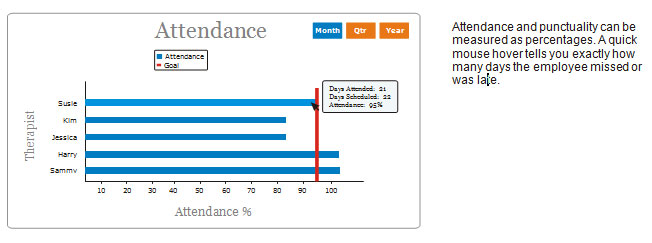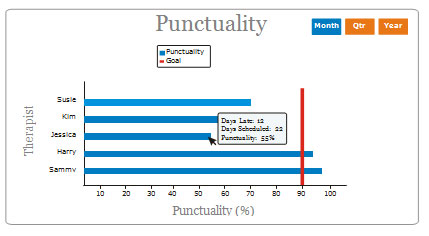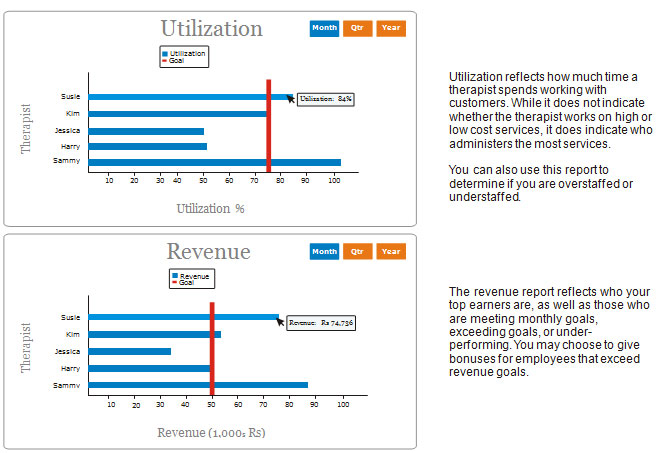Zenoti Whitepaper
A Simple Method To Retaining and Motivating Employees
With the explosive growth in the spa and salon industry, spa and salon owners today are faced with increased competition, a shortage of talented professionals, and employees that have other opportunities readily available. Unlike other retail businesses, the relationship your employees create with your customers during treatments is not easily replaceable. One of the biggest challenges for you, as a spa owner, is to retain your best employees
In this white paper, you'll learn how easy it can be to retain and motivate your employees.
A Very Real Threat to Your Business
All spa and salons look to boost productivity, reduce costs, increase margins and 'wow' their customers. The challenge in doing so is to retain the employees that help you meet these goals. In an industry driven by personalized service and relationships, it's the quality and consistency of service your employees deliver that enables you to keep 'wowing' customers. Few industries have such a strong affinity between employees and customers, which make good employees a crucial factor in the success of your business.
With an industry attrition rate of 30%, spas and salons spend significant time and money to hire and train new employees. Losing good employees not only leaves you with a skill drain and the need to find a replacement, but also gives your competition a leg up!
Industry surveys indicate 5 common reasons why employees leave:
- unfair compensation for performance
- lack of HR policies
- too few growth opportunities
- unfair treatment from their manager
- personal reasons
Identifying your Best Employees
Assume that you can't be at your spa 24/7 and rely on your manager for day-to- day operations. If you asked your manager to identify the best performers, would his response match your expectations?
If you then asked him how he identified his best performers, would you hear responses like "Raj is well trained and highly skilled" or "a lot of people think Kat is good"?
While these are good indicators, feedback is often subjective and runs the risk of bias.
Managers intend to be fair and consistent when rating employees, but hectic day- to-day running of the business and lack of the right measures leave much to the discretion of the manager. This can lead to faulty decisions and leave many employees feeling unrecognized and a sense of unfairness.
Providing Transparency
It's fair to say that every employee comes in to work to do their best. They look to you, the owner, or the manager for support and to set expectations.
If you can identify and communicate what you expect from your employees, they will have clear goals to aim towards. Just as importantly, you and managers have clear goals to measure employees against.
Employees will work in confidence that if they achieve those goals, they will be recognized and rewarded, and gain a sense of fairness in your evaluation of their performance.
Identifying Goals
By providing goals, you provide a level of transparency to both manager and employees on how performance is evaluated.
In order to identify goals, you should first consider what makes a good employee. For example, you might expect a good employee to be someone who handles guests professionally, is highly skilled at treatments, and has consistent, positive interactions with customers.
While these indicators are meaningful, they are subjective and difficult to track. The best goals can be measured and tracked.
Identifying goals are easier than you might expect. The following goals capture employee professionalism, overall value and customer satisfaction - and can also be measured and tracked
- Attendance: Employees who regularly come in to work on the days they are scheduled are reliable. Good attendance also reflects professionalism. You may expect your employees not to miss any working days, in which case your goal would be 100% attendance.
- Punctuality: In the spa and salon industry, therapists that come in late can cause chaos to schedules and often results in customer dissatisfaction. Punctuality not only is required for good operations but also reflects professionalism.
You may expect your employees to always be punctual, in which case your goal would be 100% punctuality - Utilization: Utilization indicates the percent of time in a day the therapist spent working with a guest. In other words, a busy therapist has a high utilization. A goal of 50% typically balances out peak and non-peak hours
- Revenue: Revenue indicates how much money your therapist Contributes. This goal varies from business to business depending on size and Monthly revenue. Set a reasonable goal for each therapist.
- Customer Satisfaction: Therapists who maintain high customer satisfaction are likely to build customer loyalty. This goal measures the average rating from customers. Ratings are most commonly collected from feedback forms. Look at the rating system used on your feedback forms and select a reasonable goal. You could set the goal for the employee to maintain an average high rating, or even to ensure that an employee should not receive more than 5 poor ratings per Month.
- Customer Retention: Customer retention measures the ability for your therapist to get new or existing customers to come back for a next visit. This is a strong indicator of employee performance.
Do you expect your therapists to retain 5 out of every 10 new visitors? If so, set the goal for customer retention at 50%, or adjust to a level that makes sense for your business.
These six goals provide a comprehensive set of indicators to evaluate employees. While there aree subjective ways to evaluate performance, these goals do an excellent job of measuring employee performance objectively and fairly.
The next step now is to determine how you go about tracking performance.
Tracking Performance
You may choose to track employee performance manually. Attendance can be gathered from employee schedules and rosters, punctuality from time clocks or registers, utilization from your appointment book, revenue from your POS or billing system and appointment book. Customer satisfaction can be gathered by collating data from customer feedback forms and customer retention would require a guest registry and appointment book.
Doing the calculations manually, however organized you are, could cost many man hours. Luckily, in today's digital age, software tools can easily track performance without any additional effort from you.
Softwares like Zenoti, provide easy to understand reports that help you monitor performance at a glance. You save time from having to run manual calculations and also require little effort to monitor employee performance.
In fact, managers may choose to look at performance reports 10 minutes before a weekly staff meeting!
Reports from Zenoti
Reports enable you to monitor employee performance at a glance. Reports generate automatically based on data collected through the appointment book. This means you don't put any effort beyond setting goals!
The red line indicates the goal you've set for your employees. Employees that do not meet the red line are under-performing.




Show this data to the people that matter. Weekly staff meetings are an ideal place to call out any warning signs for poor performance as well as acknowledge good performance.
Providing this level of transparency mitigates feelings of unfairness and sets a professional tone for the work environment.
Motivate Your Employees!
By clearly identifying, sharing and tracking performance, you can easily identify good and poor performers. With the confidence in the accuracy of this data, use this data to motivate your employees. Two highly effective methods for motivation include acknowledgment and remuneration incentives. As employee evaluation is fully transparent, unbiased, and use metrics that have been bought-into by employees, you'll gain more credibility in reward and remuneration programs. Consider using performance data to support:
Employee Awards: With a number of goals and data available, set up interesting awards - things like "Best Attendance", "Employee of the Month" or even "Most Improved". Acknowledging employees at regular intervals and doing so publicly serve as a powerful motivation tool. Awards boost morale and make others aspire for the same recognition. Use monthly or quarterly awards to recognize different employees and annual awards for the most consistent performers.
Monthly Incentives: Incentives can be used as bonuses for individuals or groups that meet goals. You may also choose to incorporate incentives as part of the employee compensation plans.
Salary and Compensation: Performance goals reflect the actual skill and value an employee brings to your business. Use this data during annual salary and compensation reviews.
Conclusion
Good employees build a strong, loyal customer base, which your business survives on. Combined with the cost of hiring and retraining, employee retention is a crucial factor to the success of your business.
Identifying and sharing measurable goals with your employees provides a transparent and unbiased method to retain and motivate employees. Its easier than you might think to implement a strong retention and motivation strategy in place. Using management software like Zenoti can help you achieve outstanding results, while requiring little more than 5 minutes a week to review reports!
To watch Zenoti in action, watch the video tours on our Website.
- Define Performance Goals and TrackEmployee Performance
- Create Employee Schedules Effortlessly
More whitepapers with management insights
for your spa and salon.
- Find the Right Spa or Salon Software for Your Spa or Salon
- An Easier Method To Inventory Management For Your Spa or Salon
- Maximizing Staff Utilization
- Maximize Revenue With Marketing Campaigns
- A Simple Method To Retain and Motivate Employees
- Guaranteed Customers For Life
- Effectively Up Selling Through Memberships
